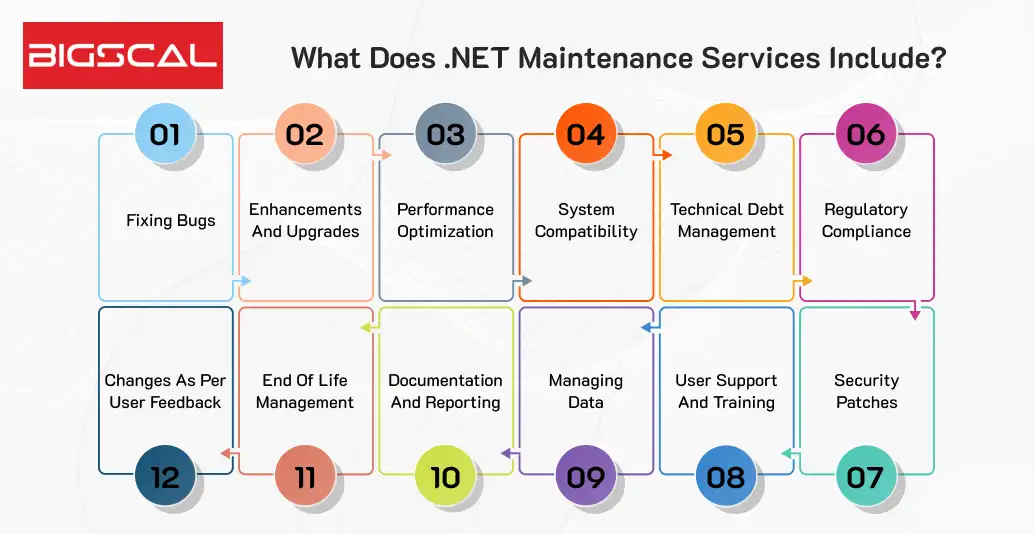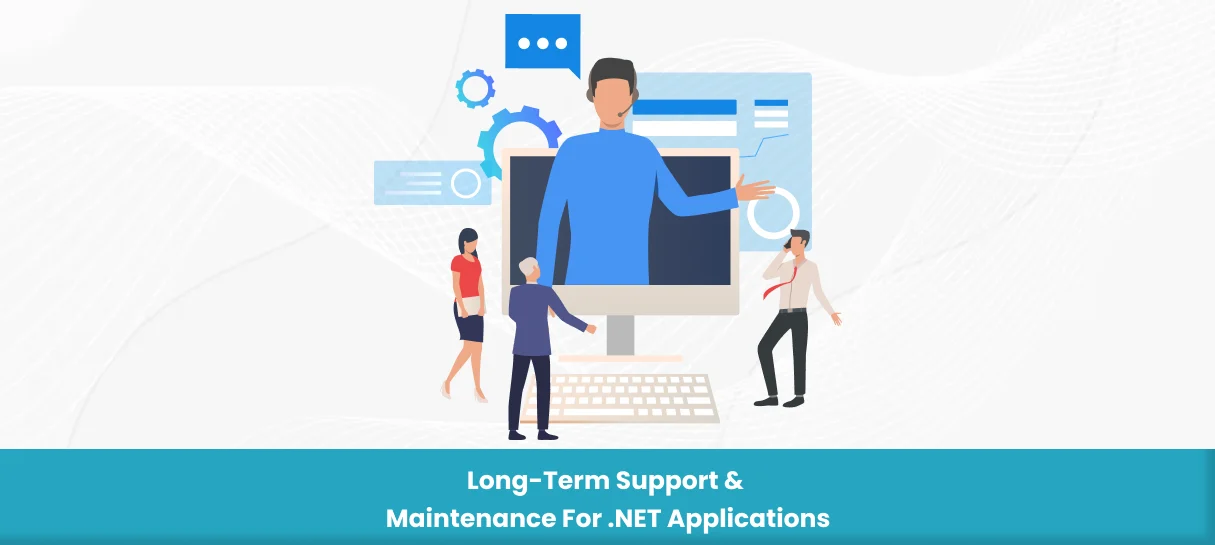Long-Term Support & Maintenance for .NET Applications
Quick Summary:Keeping your .NET application in the top shape isn’t just about updating it. It goes way beyond this for securing future usage. This blog helps you dive deep into .NET maintenance services. We will help you understand how to keep applications up to date for better performance and customer satisfaction. It will also help you know if your version is out of support and what actions you should take.
Introduction
Newer versions of .NET will be out soon but the complexity of maintenance and support will still be the same. They are too confusing to understand. There are multiple versions of .NET framework which includes .NET 9, .NET core, standard version and more. All of these have different cycles and end of support dates.
If you are familiar with .NET application development then you might have heard about “Long Term Support” from the year 2020. But the exact duration of this support is not obvious just like “Standard Term Support.”
Through this blog we will try to understand what it means to have application support and maintenance. Also we will uncover how longer your .NET maintenance services will be supported. It will undoubtedly assist you in making better plans for your application’s future with .NET development services.
What do you mean by application maintenance and support services?
We’ve all probably heard that maintaining and providing support for.NET applications is essential. But what does this actually mean? These are essentially services that make sure your application is operating smoothly and effectively.
Application maintenance involves making regular changes to it to make sure that the application is functional and relevant to the market. This process comprises steps such as fixing bugs, enhancing performance and updates so that software is compatible with latest technologies and OS. Additionally, maintenance is also necessary for ensuring great application performance, solving any issue and checking if it meets user expectations.
On the other hand .NET application support provided continuous assistance to users and administrators for solving problems and smooth functioning. It involves processes such as troubleshooting, user training, and providing technical assistance for any issue that arises while operating. It aims at resolving problems quickly to avoid downtime and provide satisfaction to users.
These maintenance and support activities are key contributors to long term success for providing profits to businesses. By ensuring that applications are up to date you can avoid any problems and ensure smooth operations. Better user satisfaction can ensure great user experience for retention of customers.
What does .NET maintenance services include?

Maintaining a .NET application comprises different practices that all together are responsible for proper functioning of application and meeting the ever increasing needs. Here’s what it all comprises of:
Fixing bugs
Identifying and resolving bugs is one of the critical steps to ensure that software runs smoother. In this process, developers troubleshoot the issues reported by users in .NET applications. They also deploy new updates to fix bugs.
Enhancements and upgrades
To stay competitive and ensure that the application is relevant there is constant need to make new upgrades. This step might involve adding new technologies and revise these functionalities as per the user inputs.
Performance optimization
A necessary maintenance thing that has to be done regularly is ensuring better performance which means better speed. For this purpose, developers optimize code and algorithms, adjust configurations and scale resources for adaptability and dependability.
System compatibility
Ensure that you update your application to function with the latest operating systems, technology and devices. It updates your software with the latest developments and improves its functionality.
Technical debt management
It is the step where improvement in parts software is done that were not properly written initially at the time of development. This process is called refactoring. It involves cleaning code, removing unnecessary parts, and making it more clear and readable. Also it consists of upgrading documentation so that future developers could view making maintenance more easier.
Regulatory compliance
Keep on updating your application to meet the evolving legal, regulatory and safety standards. It consists of compliance with the data safety standards, financial rules and other relevant regulations to prevent risks and gain trust of users.
Security patches
To secure applications from any harm it is necessary to implement security patches and updates. It protects your application from vulnerabilities. You must hire ASP.NET core developers for better upgrades. This consists of reviewing security regularly and using fixes to safeguard user data and avoid unnecessary access.
User support and training
It is the point where you provide consistent assistance to users and administrators. It also includes resolving issues, answering common problems and providing guidance to users for better usage of applications.
Managing data
It is necessary to ensure safety and integrity of the data. It includes data backup, performing data recovery and providing best and up to date data handling.
Documentation and reporting
Keeping track of updates, modifications, and maintenance actions. It helps you understand the progress, provide details for any improvement to be made in future and ensure communication between stakeholders.
End of life management
Every application has a lifespan, and.NET applications are no exception. Therefore, it is essential to organize and oversee its replacement. This process consists of migrating user data and transitioning them to new applications.
Changes as per user feedback
Your application must be adaptable to user inputs or feedback. It can enhance the quality and performance of your application. Regularly using customer feedback to identify the area for improvement can ensure that your application meets client expectations.
What does .NET application support include?

.NET Application support is a range of services performed to ensure that software is working smoothly and efficiently. Here’s what it does:
Resolving issues
Resolving issues faced by users promptly and timely and addressing them with right fixes. This step involves fixing bugs and errors that harm functionality of the application.
Technical assistance
Providing assistance with the technical concepts of application such as integration issues, configuration and more. This support will aid users in dealing with any technical challenge so they can easily use software.
User training
Setting up training sessions or resources that can be used by users to gain insight into the application usage. This step involves developing user manuals, tutorials and setting up training sessions for user proficiency.
Monitoring performance
Monitor the performance of your.NET application. It will help you ensure that it works efficiently for positive user experience. Make sure that your .NET development services providers provide you with performance metrics. It includes watching key metrics, spotting potential issues and taking necessary measures to maintain best performance. Hire .NET developers for this purpose.
Software updates
Make sure you update patches regularly and upgrade your application with the latest features. Also improve its security and enhance its overall functioning. It helps in keeping software’s performance intact.
Need reliable .NET application development?
- Regular updates
- 24/7 support
Difference between .NET application maintenance and support
| Aspect | .NET Application Maintenance | .NET Application Support |
|---|---|---|
| Purpose | Focuses on improving and optimizing existing applications over time. | Focuses on resolving immediate issues and ensuring smooth daily operation. |
| Scope | Includes code refactoring, performance tuning, and updating outdated components. | Involves bug fixing, error handling, and assisting users with technical problems. |
| Objective | Enhance system efficiency, scalability, and long-term stability. | Maintain uninterrupted functionality and user satisfaction. |
| Time Frame | Ongoing and strategic – performed periodically or after major releases. | Reactive and immediate – performed whenever an issue arises. |
| Key Activities | Refactoring code, upgrading frameworks, enhancing security, and improving documentation. | Monitoring, troubleshooting, debugging, and providing technical assistance. |
| Team Involvement | Usually handled by developers focused on long-term improvement. | Usually managed by technical support or operations teams. |
| End Goal | Reduce technical debt and future development costs. | Ensure continuous uptime and user accessibility. |
Variation in support policy by .NET platform
The LTS and STS we have talked about is only valid for the .NET platform but for others these policies might vary. Here’s a quick summary for you:
.NET is a framework released in 2002 and since then many other versions were also released which ranges from 1.0 to 4.8. Hence the support policies also vary and most of them are out of support now but some exceptions are:
- .NET 3.5 framework will be in support till April 2029.
- .NET 4.8 framework will depend on the operating system it is tied to. However it is in the support for the coming ten years.
Again .NET core was an evolution of the framework and has various releases ranging from 1.0 to 3.1. However this version has also reached the out of support era and the .NET core 3.1 support ended in December 2022.
.NET standard: It was a bridge between two versions .NET and .NET framework. The last version was 2.1 yet its support was later paired to the latest version extending it for future.
Xamarian: Xamarian is a revolutionary in the field of mobile app development providing ability to develop cross platform applications using C# codes. Its support ended on 1st May 2024. Users were said to elevate .NET MAUI.
The existing .NET series is the latest version that starts from .NET 5 launched in 2020. Hence Microsoft provides support policy for this such as:
- Standard term support: 2 years for the ones that have odd numbers.
- Long term support: 3 years for those with even numbers for .NET software development.
Note
Know that the older versions might not stop working instantly but upgrading them is a smart move.
What actions should I take?
Are you worried about what to do if your support has ended. Here’s something to assist you.
- If you are using .NET framework don’t worry as it’s not an emergency to upgrade it’s still in support.
- On the other hand if you use .NET core it’s out of support and you need to migrate ASAP.
- And if you are only on .NET be known to the date when it goes out of support. Immediately update your plan accordingly.
Conclusion
To sum up .NET application maintenance and support is not just about fixing errors but also ensuring functionality to its best. It assists you in ensuring that your program functions properly to satisfy users. You must regularly update, optimize and monitor performance of your system to protect your investment and deliver optimum results to your users.
Partner with the best and reliable .NET maintenance services like Bigscal to stay ahead of risks and focus on growth while your application is working seamlessly.
FAQ
How does ongoing support reduce app downtime?
Regular .NET maintenance service will make sure that you monitor and fix issues promptly so that the application stays stable and minimizes downtime.
What is included in .NET maintenance services?
It includes fixing bugs, updates, optimizing codes, security patches and providing compatibility with the latest technologies.
Why is .NET application maintenance necessary?
It ensures that your application is safe, secure and up to date with the latest technologies in the market. Additionally, it improves user experience.
How often should I perform .NET maintenance?
You must conduct .NET maintenance after a quarter or after every major update release to ensure smooth performance.
What is Long Term Support in .NET?
It means that Microsoft facilitates three years of updates, patches, and security fixes for stable releases such as .NET 6.
What happens when a .NET version is out of support?
If your .NET version is out of support, you will not receive updates or security fixes, making your application more vulnerable.
What is the end of life management in .NET applications?
It is the process that consists of migrating data, transferring users, and upgrading to newer versions of the .NET framework.
How can maintenance enhance user satisfaction?
Regular updates and fixing bugs enhance the performance of your .NET application, improving user satisfaction.
Can .NET maintenance be outsourced?
Absolutely, there are many businesses that outsource .NET application maintenance to experts for cost efficiency and fast updates.
Does refactoring help reduce maintenance costs?
Yes, refactoring code will help you enhance the quality of code for easy maintenance in the future and avoid expensive rework.





